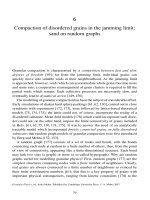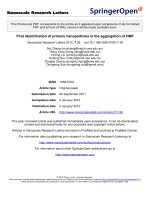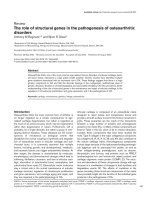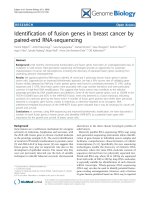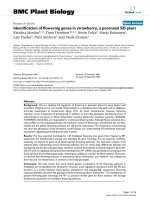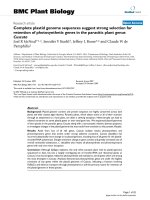Identification of pluripotency genes in the fish medaka
Bạn đang xem bản rút gọn của tài liệu. Xem và tải ngay bản đầy đủ của tài liệu tại đây (2.9 MB, 95 trang )
IDENTIFICATION OF PLURIPOTENCY GENES IN THE
FISH MEDAKA
WANG DANKE
(B.ENG)
A THESIS SUBMITTED
FOR THE DEGREE OF MASTER OF
SCIENCE
DEPARTMENT OF BIOLOGICAL SCIENCE
NATIONAL UNIVERSITY OF SINGAPORE
2011
i
ACKNOWLEDGEMENT
My greatest gratitude goes to my supervisor, Associate Professor Hong
Yunhan, for his support and supervision during the whole project. Especially
thank him for his discussion and understanding of every decision I made for
my future.
My thanks also go to Dr Li Zhendong, for his patience and expert guidance
throughout my research work in NUS. Thanks also to Dr Guan Guijun, Miss
Hong Ni, Dr Li Mingyong, Mr Yan Yan, Dr Yi Meisheng, Dr Yuan Yongming and
Dr Zhao Haobin for their assistance, suggestions, and troubleshooting.
In addition, I would like to thank Mdm Deng Jiaorong for fish breeding and Miss
Foong Choy Mei for laboratory management. To all my friends in the laboratory,
Mr Jason Tan, Mr Kwok Chee Keong, Mr Lin Fan, Miss Manali A. Dwarakanath,
Miss Narayani Bhat, and Mr Wang Tiansu, thank them for all the laughter they
brought to my life in the lab. Also my thanks go to Miss Ho Danliang, for her
guidance and help in my part-time teaching assistant position. Finally, I would
like to thank Miss Justina Shihui Tong, who taught me a lot in the experiment in
my lab rotation.
i
TABLE OF CONTENTS
ACKNOWLEDGEMENT ...................................................................................................................... I
ABSTRACT ..........................................................................................................................................IV
LIST OF TABLES ................................................................................................................................VI
LIST OF FIGURES ............................................................................................................................ VII
CHAPTER 1: INTRODUCTION .......................................................................................................... 1
1.1 STEM CELL ...................................................................................................................................... 1
1.1.1 Stem cell ............................................................................................................................... 1
1.1.2 Pluripotent stem cell ............................................................................................................ 2
1.2 TRANSCRIPTION FACTORS ............................................................................................................... 3
1.2.1 Oct4 ....................................................................................................................................... 4
1.2.2 Nanog .................................................................................................................................... 5
1.2.3 Other transcription factors .................................................................................................. 7
1.3 MEDAKA ....................................................................................................................................... 13
1.4 MIDBLASTULA TRANSITION ........................................................................................................... 14
AIM ..................................................................................................................................................... 15
CHAPTER 2: METHOD...................................................................................................................... 16
2.1 ANIMAL STOCK AND MAINTENANCE .............................................................................................. 16
2.2 EXPRESSION PATTERN ANALYSIS .................................................................................................... 16
2.2.1 Collection of adult tissue .................................................................................................. 16
2.2.2 Madaka embryo collection ............................................................................................... 17
2.2.3 Cell culture .......................................................................................................................... 18
2.2.4 Isolation of total RNA ........................................................................................................ 19
2.2.5 Sequence analysis and gene identification. .................................................................. 20
2.2.6 Reverse-Transcription Polymerase Chain Reaction (RT-PCR) .................................. 21
2.2.7 qPCR ................................................................................................................................... 24
2.3 MOLECULAR CLONING .................................................................................................................. 25
2.3.1 Recovery of PCR products from agarose gel................................................................ 25
2.3.2 TA cloning ........................................................................................................................... 25
2.3.3 Preparation of competent cells (RbCl method) ............................................................. 26
2.3.4 Transformation of competent cells .................................................................................. 27
2.3.5 Minipreps of plasmids (Alkaline lysis method) .............................................................. 27
2.3.6 Plasmid screening by restriction enzyme digestion ..................................................... 28
2.3.7 Sequencing ........................................................................................................................ 29
2.3.8 Midiprep of plasmids ......................................................................................................... 30
2.4 IN SITU HYBRIDIZATION ................................................................................................................. 30
2.4.1 Synthesis of RNA probes ................................................................................................. 30
2.4.2 Whole mount in situ hybridization (WISH) ..................................................................... 31
ii
2.4.3 Section in situ hybridization (SISH) ................................................................................ 33
2.4.4 Fluorescent in situ hybridization(FISH) .......................................................................... 34
2.4.5 Microscopy and photography .......................................................................................... 35
2.5 ZYGOTIC EXPRESSION EXAMINATION ............................................................................................ 35
2.5.1 Gene cloning in O. celebensis ......................................................................................... 35
2.5.2 Sequence analysis and species specific primer design .............................................. 36
2.5.3 In vitro fertilization ............................................................................................................. 37
2.5.4 Zygotic expression examination ...................................................................................... 38
CHAPTER 3: RESULTS..................................................................................................................... 39
3.1 GENE IDENTIFICATION ................................................................................................................... 39
3.2 EXPRESSION PATTERN ANALYSIS .................................................................................................... 43
3.2.1 RT-PCR analysis of expression in tissues ..................................................................... 43
3.2.2
RT-PCR analysis of expression in embryos ............................................................... 45
3.2.3 in vivo expression in embryos and the adult gonad ..................................................... 46
3.2.4 Expression in ES cell culture ........................................................................................... 50
3.2.5 Quantitative-PCR analysis of expression in ES cell culture ........................................ 52
3.3 ZYGOTIC EXPRESSION EXAMINATION ............................................................................................ 54
3.3.1 Gene Cloning in O. celebensis ........................................................................................ 54
3.3.2 Sequence analysis ............................................................................................................ 55
3.3.3 RT-PCR analysis using species-specific primer ........................................................... 63
CHAPTER 4: DISCUSSION .............................................................................................................. 65
4.1 GENE IDENTIFICATION ................................................................................................................... 65
4.2 IDENTIFICATION OF PLURIPOTENCY MARKERS ............................................................................... 68
4.2.1 nanog and oct4 .................................................................................................................. 68
4.2.2 Other genes ........................................................................................................................ 70
4.2.3 Somatic expression of pluripotency genes .................................................................... 71
4.2.4 Conserved expression of pluripotency genes in vertebrates ...................................... 73
4.3 ZYGOTIC EXPRESSION PATTERN ..................................................................................................... 74
4.3.1 Zygotic expression at midblastula ................................................................................... 74
4.3.2 O. celebensis in building the zygotic expression examining model ........................... 76
4.3.3 Hierarchical expression among pluripotency genes..................................................... 77
CHAPTER 5: CONCLUSION AND FUTURE WORK .................................................................... 80
5.1 CONCLUSION ................................................................................................................................. 80
5.2 FUTURE WORK .............................................................................................................................. 81
CHAPTER 6: REFERENCES ............................................................................................................ 82
iii
ABSTRACT
Stem cell cultures can be derived directly from early developing embryos and
indirectly from differentiated cells by forced expression of pluripotency
transcription factors. Pluripotency genes are routinely used to characterize
mammalian stem cell cultures at the molecular level. However, such genes
have remained unknown in lower vertebrates. This study made use of the
laboratory fish medaka as a model, because of its unique embryonic stem (ES)
cells and sequenced genome as useful experimental tools and genetic
resource. Seven medaka pluripotency genes were identified by homology
search and expression in vivo and in vitro. By RT-PCR analysis, they fall into
three groups of expression pattern. Group I includes nanog and oct4 showing
gonad-specific expression; Group II contains sall4 and zfp281 displaying
gonad-preferential expression; Group III has klf4, ronin and tcf3 exhibiting
expression also in several somatic tissues apart from the gonads. The
transcripts of the seven genes are maternally supplied and persist at a high
level during early embryogenesis. Early embryos and adult gonads were used
to examine expression in stem cells and differentiated derivatives by in situ
hybridization. Strikingly, nanog and oct4 are highly expressed in pluripotent
blastomeres of 16-cell embryos. In the adult testis, nanog expression was
iv
specific to spermatogonia, the germ stem cells, whereas tcf3 expression
occurred in spermatogonia and differentiated cells. Most importantly, all the
seven genes are pluripotency markers in vitro, because they showed high
expression in undifferentiated ES cells but dramatic down-regulation upon
differentiation.
Therefore,
these
genes
have
conserved
their
pluripotency-specific expression in vitro from mammals to lower vertebrates.
Furthermore, by using sequence differences between two medaka species: O.
latipes and O. celebensis, I built a model to examine the timing of zygotic
expression of six pluripotency genes by determining their expression from the
paternal alleles. All those genes showed the onset of zygotic expression
around the midblastula transition, suggesting their critical roles in early
embryogenesis. Specifically, nanog and oct4 show earlier expression than the
other remainder. Data obtained suggest the feasibility to study the hierarchical
expression patterns of genes involved in pluripotency, cell fate decision and
other processes.
v
LIST OF TABLES
Table 1
Genes and Primers used in RT-PCR for expression pattern
analysis
Table 2
Genes and Primers used in qPCR
Table 3
Genes and Primers used for gene cloning
Table 4
Genes and Primers used in RT-PCR for examining zygotic
expression
Table 5
Summary of RNA expression in medaka adult tissues
Table 6
Summary of zygotic expression in medaka embryos
Table 7
The hierarchy of zygotic activation
vi
LIST OF FIGURES
Figure 1
Sequence comparison of E2A (E12/E47) proteins on alignment
Figure 2
Phylogenetic comparison of Tcf3/Tcf7l1 proteins
Figure 3
RT-PCR analysis of RNA expression in adult tissues
Figure 4
RT-PCR analysis of RNA expression in embryos
Figure 5
RNA expression by in situ hybridization
Figure 6
RNA expression in ES cell culture (RT-PCR)
Figure 7
RNA expression in ES cell culture (qPCR)
Figure 8
RT-PCR results of seven genes in O. latipes and O. celebensis
Figure 9
Alignment of nanog cDNAs between O. celebensis and O. latipes
Figure 10
Alignment of oct4 cDNAs between O. celebensis and O. latipes
Figure 11
Alignment of sall4 cDNAs between O. celebensis and O. latipes
Figure 12
Alignment of klf4 cDNAs between O. celebensis and O. latipes
Figure 13
Alignment of ronin4 cDNAs between O. celebensis and O. latipes
Figure 14
Alignment of tcf3 cDNAs between O. celebensis and O. latipes
Figure 15
Alignment of zfp281 cDNAs between O. celebensis and O. latipes
Figure 16
RT-PCR analysis of zygotic RNA expression in embryos (O.
celebensis male X O. latipes female)
Figure 17
RT-PCR analysis of zygotic RNA expression in embryos (O. latipes
male X O. celebensis female)
vii
CHAPTER 1: INTRODUCTION
1.1 Stem cell
1.1.1 Stem cell
Stem cells, found in all multicellular organisms, can divide through mitosis and
differentiate into diverse specialized cell types and can self renew to produce
more stem cells. Stem cells are defined based on three characteristics: they
can undergo self-renewing cell divisions in which at least one of the daughter
cells is a stem cell; they can give rise to multiple types of cell; they must be
capable of repopulating a tissue in vivo (Verfaillie, 2009).
Potency specifies the differentiation potential of the stem cell. Generally, there
are five kinds of potency in stem cell. Totipotency is the ability of a single cell to
divide
and
produce
all
the
differentiated
cells
in
an
organism.
Pluripotency refers to the potential of the stem cells to differentiate into any of
the three germ layers: endoderm, mesoderm or ectoderm. However,
pluripotent stem cells lack the potential to contribute to extraembryonic tissue.
Multipotent stem cells can differentiate into a number of cells, but only those of
a closely related family of cells. In addition, there are also oligopotent and
unipotent cells.
All mammals are derived from a single stem cell, which is known as the
totipotent stem cell, such as zygote. During embryogenesis, stem cells
undergo specification to give rise to extraembryonic endoderm or cells of the
1
inner cell mass (ICM), which are pluripotent. Cells in the ICM then differentiate
to three germ layers cells and finally to tissue specific stem cells. With each
additional step of specification, cells become more and more limited in their
differentiation ability. These stem cells present in tissues of the three germ
layers cannot generate cells of other tissues within the same germ layer or of
the other germ layers, but the cells of that tissue. These cells are therefore
multipotent (Verfaillie, 2009).
1.1.2 Pluripotent stem cell
In mammals, there are two broad types of stem cells: embryonic stem (ES)
cells that are isolated from the ICM of blastocysts, and adult stem cells that
are found in various tissues. ES cells have the ability to grow indefinitely while
maintaining pluripotency and the ability to differentiate into cells of all three
germ layers (Evans and Kaufman, 1981).
Pluripotent stem cell cultures can be derived from developing embryos and
adult tissues. In particular, ES cells from early developing embryos are an
excellent model for analyzing vertebrate development in vitro, and provide a
versatile resource for induced differentiation into many desired cell types in
large quantity for regenerative medicine. In mouse, ES cells have widely been
used in gene targeting for generating knockout animals to study the functions
of genes and to model human diseases (Wobus and Boheler, 2005). Since the
production of first mouse ES cell lines in 1981 (Evans and Kaufman, 1981),
numerous attempts have been made in ES cell derivation in different
2
vertebrate organisms (Munoz et al., 2009; Yi et al., 2010b). The success in the
production of ES cells from the fish medaka (Hong et al., 1996) demonstrated
that the ability for ES cell derivation is present from fish to mammals. In 1998,
human ES cells were successfully established (Thomson et al., 1998).
Previously, somatic cells can be reprogrammed by transferring their nuclear
into oocytes (Wilmut et al., 1997) or by fusing the somatic cells with ES cells
(Cowan et al., 2005; Tada et al., 2001). At present, induced pluripotent stem
(iPS) cells can be generated from differentiated cells by introduced expression
of reprogramming transcription factors (Takahashi et al., 2007; Takahashi and
Yamanaka, 2006; Yu et al., 2007).
Although interest in ES cell derivation has steadily been increasing and
putative ES-like cells have been reported in several species (Hong N, 2011; Yi
et al., 2010b), including short-term ES cell cultures capable of germline
transmission in zebrafish(Ma et al., 2001a), stable lines of real ES cells have
been limited to few organisms. One of the challenges is that there are no
suitable molecular markers to monitor and regulate the pluripotency of putative
ES cell cultures.
1.2 Transcription factors
Recent studies have established that mouse and human ES cells share a core
transcriptional network consisting of Oct4, Nanog and Sox2 (Boyer et al.,
2005b; Loh et al., 2006b). Oct4 and Nanog, are essential regulators of early
development and ES cell identity (Chambers et al., 2003; Nichols et al., 1998).
3
1.2.1 Oct4
In 2006, Shinya Yamanaka demonstrated induction of pluripotent stem cells
from mouse embryonic and adult fibroblasts by introducing four factors, Oct4,
Sox2, c-Myc and Klf4, under ES cell culture conditions (Takahashi and
Yamanaka, 2006). The second year, his group reported the induction of
pluripotent stem cells from adult human fibroblasts using the same factors
(Takahashi et al., 2007). The same year, James A. Thomson demonstrated
that transcription factor Oct4, Sox2, Nanog and Lin28 are sufficient to
reprogram human somatic cells to pluripotent stem cells that exhibit the
essential characteristics of embryonic stem (ES) cells (Yu et al., 2007). In all
those three studies, Oct4 is the key factor in induced pluripotent stem (iPS)
cells.
The mouse oct4 gene (also known as pou5f1) encodes a POU
domain-containing and an octamer-binding protein and represents the
prototype of pluripotency genes in mammals, because it is maternally supplied
and expressed specifically throughout the totipotent cycle, including the inner
cell mass (ICM), epiblast and primordial germ cells (PGCs) of early developing
embryo and spermatogonia and oocytes (Pesce et al., 1998b). These
embryonic and adult cells are all capable of producing stem cell cultures, in
which quantitative Oct4 expression defines differentiation, dedifferentiation or
self-renewal(Niwa et al., 2000b). Oct4-null embryos develop abnormal ICM
cells which are not pluripotent and have a greater propensity to express
4
trophoblast markers and subsequently die at the peri-implantation stage of
development (Nichols et al., 1998). When Oct4 expression is repressed in ES
cells, cells lose their self-renewing state and spontaneously differentiate to the
trophectodermal lineage (Nichols et al., 1998; Niwa et al., 2000a).
Oct4 can act either to repress or to activate target gene transcription (Pesce
and Schöler, 2001). It regulates expression of multiple genes (Saijoh et al.,
1996) via interactions with transcription factors present in pluripotent cells. For
example, Oct4 can heterodimerize with Sox2, to affect the expression of
several genes in mouse ES cells (Botquin et al., 1998).
It was also reported that ES cells maintain Oct4 at an appropriate level in order
to remain pluripotency. Either increase or decrease in expression of oct4 may
induce ES cells to differentiate (Niwa et al., 2000a). ES cells with oct4
downregulation differentiate to the trophectodermal lineage, while ES cells with
an overexpression of oct4 tend to differentiate to multiple cell types (Niwa et al.,
2000a).
1.2.2 Nanog
Nanog is one of the transcription factors used in human somatic cells
reprogramming (Yu et al., 2007).
The gene nanog encodes a divergent protein that contains a homeobox. Its
expression commences at the morula stage and later on occurs in the ICM,
epiblast, PGCs and ES cell cultures, albeit its expression is absent in
spermatogonia of the adult testis (Cavaleri and Scholer, 2003; Chambers et al.,
5
2003). Nanog is one of the key regulators essential for the formation and
maintenance of the ICM during mouse pre-implantation development and for
self-renewal of pluripotent ES cells (Loh et al., 2006a)
Embryos devoid of Nanog were unable to form epiblasts. (Mitsui et al., 2003)
Such embryos seem to be able to initially give rise to the pluripotent cells, but
these cells then immediately differentiate into the extraembryonic endoderm
lineage (Loh et al., 2006a).
Similar to oct4, nanog is downregulated upon ES cells differentiation and ES
cells deficient in Nanog differentiate into cells of the extraembryonic endoderm
lineage (Mitsui et al., 2003). Hence, it is commonly stated that both Nanog and
Oct4 are critical in maintaining pluripotency in ES cells.
However, contrary to previous findings, in other studies, Nanog-deficient ES
cells were able to self-renew with Oct4 and Sox2 maintained (Chambers et al.,
2007). Therefore, such result gives rise to a conclusion that Nanog is essential
for establishing pluripotency but is dispensable for the maintenance of
self-renewal and pluripotency in ES cells (Heng and Ng, 2010). In the further
study of the key transcription factor, namely Oct4, Nanog and Sox2, to
maintain pluripotency in ES cells, researcher concluded that although each of
these proteins has been described as a “master regulator” of pluripotency, only
Oct4 appears absolutely essential, while both Sox2 and Nanog appear
dispensable, at least in certain molecular contexts (Masui et al., 2007).
6
1.2.3 Other transcription factors
Additional pluripotency genes have recently been described in mammals.
These include klf4 encoding a Krüppel-like factor(Takahashi and Yamanaka,
2006), ronin encoding the THAP domain containing 11 protein (Thap11)
(Dejosez et al., 2008b), sall4 encoding the Sal-like protein 4 (Sall4) (Lim et al.,
2008; Tsubooka et al., 2009a), tcf3 (also called tcf7l1) encoding the T-cell
transcription factor 3 (Cole et al., 2008a; Tam et al., 2008a) and zfp281
encoding the zinc-finger protein 281(Wang et al., 2008a). These genes have
been identified in mammalian ES cells. Their homologs/orthologs remain to be
identified and characterized in lower vertebrates.
1.2.3.1 Klf4
Klf4, which is a zinc finger transcription factors, has a defining role in
maintaining self-renewal in ES cells (Jiang et al., 2008). Overexpression of klf4
can promote the self-renewal of ES cells (Hall et al., 2009). It was also shown
that klf4 mRNA and protein expression were down-regulated during human ES
cells differentiation (Chan et al., 2009).
As a key factor in reprogramming, Klf4 functions as both a transcriptional
activator and a repressor to regulate proliferation and differentiation of different
cell types (Evans et al., 2007). Klf4 is the activator of the target gene nanog.
Overexpression of klf4 up-regulates nanog promoter activity and the
endogenous nanog protein expression in human ES cells. Knockdown of klf4
or mutation of Klf4 binding motifs significantly down-regulated nanog promoter
7
activity (Chan et al., 2009).
Genome-wide chromatin immunoprecipitation with microarray analysis
demonstrates that the DNA binding profile of Klf4 overlaps with that of Oct4
and Sox2 on promoters of genes specifically underlying establishment of iPS
cells, suggesting transcriptional synergy among these factors (Sridharan et al.,
2009). Such finding was confirmed by other findings. A dominant negative
mutant of Klf4 can compete with wild-type Klf4 to form defective
Oct4/Sox2/Klf4 complexes and strongly inhibit reprogramming (Wei et al.,
2009). This finding reinforces the idea that direct interactions between Klf4,
Oct4, and Sox2 are critical for somatic cell reprogramming (Wei et al., 2009).
Another example was also provided: Klf4 was identified as a mediating factor
that cooperates with Oct4 and Sox2 on the distal enhancer in activating the
lefty1 promoter in ES cells (Nakatake et al., 2006).
A recent study showed that introduction of single reprogramming factor, Klf4,
can induce pluripotent stem cells from epistem cell (EpiSCs), a cell line that is
from post-implantation epithelialized epiblast and unable to colonize the
embryo even though they express the core pluripotency genes, oct4, sox2 and
nanog. These EpiSC-derived induced pluripotent stem (Epi-iPS) cells
activated expression of ES cell-specific transcripts including endogenous Klf4,
and down-regulated markers of lineage specification (Guo et al., 2009).
1.2.3.2 Ronin
The protein Ronin possesses a Thap domain, which is associated with
8
sequence-specific DNA binding and epigenetic silencing of gene expression
(Dejosez et al., 2008a). It is expressed primarily during the earliest stages of
mouse embryonic development, and its deficiency in mouse produces
peri-implantational lethality and defects in the ICM (Dejosez et al., 2008a).
Meanwhile, ronin knockout ES cells were found to be nonviable. On the other
hand, the overexpression of ronin can inhibit ES cells differentiation and allows
ES cells to self-renew under conditions that normally suppress self-renewal
(Heng and Ng, 2010). Interestingly, it was found that ectopic expression of
ronin was able to partly compensate for oct4 knock-down in ES cells (Dejosez
et al., 2008a). The authors also demonstrated that Ronin is a transcriptional
repressor of multiple genes that are either directly or indirectly involved in
differentiation (Dejosez et al., 2008a). Furthermore, it was shown that Ronin
exerts its anti-differentiation effects through epigenetic silencing of gene
expression (Dejosez et al., 2008a). In addition, ronin, like nanog, is also
targeted by Caspase-3, a component of the cell death system that compels ES
cells to exit their self-renewal phase and induces differentiation (Fujita et al.,
2008). Those findings reinforce that ronin is essential for the maintenance of
pluripotent stem cells.
1.2.3.3 Sall4
A spalt family member, sall4, is required for the pluripotency of ES cells (Zhang
et al., 2006). Previously, microarray studies revealed that sall4 and oct4 share
similar expression patterns during early embryo development (Hamatani et al.,
9
2004). Similarly to Oct4, a reduction in Sall4 levels in mouse ES cells results in
respecification, under the appropriate culture conditions, of ES cells to the
trophoblast lineage (Zhang et al., 2006). Also similar to oct4, in mouse ES cells,
both overexpression and underexpression of Sall4 cause differentiation
suggesting that ES cells maintain Sall4 at an appropriate level in order to
remain pluripotency (Yang et al., 2010).
Sall4 is important for early embryonic cell-fate decisions (Zhang et al., 2006).
Sall4-null embryos died shortly after implantation (Tsubooka et al., 2009b).
Sall4 plays positive roles in the generation of pluripotent stem cells from
blastocysts and fibroblasts. Although ES-like cell lines could be established
from Sall4-null blastocysts, the efficiency was much lower. The knockdown of
sall4 significantly decreased the efficiency of iPS cell generation from mouse
fibroblasts. Furthermore, retroviral transduction of sall4 significantly increased
the efficiency of iPS cell generation in mouse and some human fibroblast lines
(Tsubooka et al., 2009b).
By using chromatin immunoprecipitation coupled to microarray hybridization,
researchers have identified a total of 3,223 genes that were bound by the Sall4
protein on duplicate assays with high confidence (Yang et al., 2008). Many of
these genes have major functions in developmental and regulatory pathways
(Yang et al., 2008). For example, Sall4 is a transcriptional activator of oct4, and
has a critical role in the maintenance of ES cell pluripotency by modulating
oct4 expression. Microinjection of sall4 small interfering (si) RNA into mouse
10
zygotes resulted in reduction of sall4 and oct4 mRNAs in pre-implantation
embryos (Zhang et al., 2006).
Although most studies generally showed the important role Sall4 plays in ES
cells, Shunsuke Yuri stated that Sall4 does not contribute to the central
machinery of the pluripotency. Instead it stabilizes ES cells by repressing
aberrant trophectoderm gene expression (Yuri et al., 2009). Such statement
provided a new point of view of the unique function of Sall4.
1.2.3.4 Tcf3
The Wnt signaling pathway is necessary both for maintaining undifferentiated
stem cells and for directing their differentiation. In mouse ES cells, Wnt
signaling preferentially maintains “stemness” under certain permissive
conditions (Tam et al., 2008b)
In searching how external signals connect to this regulatory circuitry to
influence ES cell fate, Cole found that a terminal component of the Wnt
pathway in ES cells, T-cell transcription factor-3 (Tcf3), co-occupies promoters
throughout the genome in association with the pluripotency regulators Oct4
and Nanog (Cole et al., 2008b). In mouse pre-implantation development
embryos, Tcf3 expression is co-regulated with Oct4 and Nanog and becomes
localized to the ICM of the blastocyst (Tam et al., 2008b).
Up-regulation of nanog upon tcf3 depletion showed that Tcf3 acts to repress
nanog under normal ES cell growth conditions (Pereira et al., 2006).
Furthermore, it was also found that tcf3 depletion caused increased
11
expression of Oct4, Nanog, and other pluripotency factors and produced ES
cells (Cole et al., 2008b). Comparing effects of tcf3 ablation with oct4 or nanog
knockdown revealed that Tcf3 counteracted effects of both Nanog and Oct4 (Yi
et al., 2008). However, Tcf3 is still important in maintaining pluripotency in ES
cells. Through repressing pluripotency factors, Tcf3 prevents overactivation of
transcriptional circuits, promoting pluripotent cell self-renewal (Yi et al., 2008).
Meanwhile, by using a whole-genome approach, researchers found that Tcf3
transcriptionally repressed many genes important for maintaining pluripotency
and self-renewal, as well as those involved in lineage commitment and stem
cell differentiation (Tam et al., 2008b). Thus, it was concluded that Wnt
pathway, through Tcf3, brings developmental signals directly to the core
regulatory circuitry of ES cells to influence the balance between pluripotency
and differentiation (Cole et al., 2008b).
1.2.3.5 Zfp281
The zinc finger transcription factor Zfp281 was first implicated as a regulator of
pluripotency in ES cells since it is expressed in undifferentiated ES cells and
less in differentiated ES cells (Brandenberger et al., 2004). Then, Zfp281 was
identified as a key component of the pluripotency regulatory network in a
series of studies.
Zfp281 was shown to activate nanog expression directly by binding to a site in
the promoter (Wang et al., 2008b). Its binding sites for oct4, sox2 were also
identified (Chen et al., 2008). Data in the analysis of protein interaction
12
networks in ES cells showed that Zfp281 physically interacts with Oct4, Sox2,
and Nanog in regulating pluripotency (Wang et al., 2006).
Through Chromatin immunoprecipitation, 2417 genes were identified to be
direct targets by Zfp281, including several transcription factors that are known
regulators of pluripotency (Wang et al., 2008b). Upon knockdown of zfp281,
some of the Zfp281 target genes were activated, whereas others were
repressed, suggesting that this transcription factor plays bifunctional roles in
regulating gene expression within the network (Wang et al., 2008b).
1.3 Medaka
The medaka (Oryzias latipes) is well-suited for analyzing vertebrate
development (Wittbrodt et al., 2002). This laboratory fish is used as a lower
vertebrate model for stem cell biology (Hong N, 2011; Yi et al., 2010b). In this
organism, a feeder-free culture system has been previously established that
allowed for derivation of diploid ES cells(Hong et al., 1996; Hong et al., 1998)
from midblastula embryos as the equivalent of the mammalian blastocysts,
male germ stem cells from the adult testis (Hong et al., 2004a) and even
haploid ES cells from gynogenetic embryos (Yi et al., 2009; Yi et al., 2010a).
Most recently, it was demonstrated that in medaka early embryos even up to
the 32-cell stage are capable of cell culture initiation (Li et al., 2011). In
addition, the medaka genome has been fully sequenced and partially
annotated ( The availability of sequence
data and well-characterized stem cell lines makes medaka a unique model
13
organism to identify pluripotency genes in vivo and in vitro.
1.4 Midblastula transition
Early development of the embryo is directed by maternal gene products and
has limited zygotic gene activity (O'Boyle et al., 2007). The cell divisions are
characterized by synchrony, short phases and no cell motility (O'Boyle et al.,
2007). At the midblastula transition (MBT), a series of event happens: zygotic
gene transcription is activated; the cell cycle lengthens; cell divisions lose their
synchrony; cell motility begins (Newport and Kirschner, 1982a; Newport and
Kirschner, 1982b). In the Xenopus embryos, the developmental changes
termed MBT begin after the 12th cell division (Newport and Kirschner, 1982a).
In zebrafish, it begins at the 512-cell stage (cell cycle10), two cycles earlier
than in Xenopus (Bree et al., 2005). Realization of critical nucleocytoplasmic
ratio is thought to trigger the beginning of MBT (Aizawa et al., 2003). However,
the mechanism of MBT has not been clarified.
Many of the genes that are first expressed at this stage will play critical roles in
later events such as gastrulation and segmentation (Bree et al., 2005). So in
order to obtain more insight of the function of certain gene, it is important to
study the activation of zygotic transcription.
There have been several studies to identify zygotically expressed genes in
mouse. Those methods include large scale sequencing of expressed
sequence tags from staged pre-implantation cDNA libraries (Ko et al., 2000),
mRNA differential display (Ma et al., 2001b) and suppression subtractive
14
hybridization to prepare subtract zygotic cDNA libraries (Yao et al., 2003).
However, in mouse embryo, the activation of zygotic gene expression occurs
by the 2 cell stage (Aizawa et al., 2003). In addition, transcription of some
genes even begins at 1 cell stage, such as hsp70.1 (Aizawa et al., 2003).
Because of the fast zygotic activation, it is not possible to examine more
details about the activation of genes at MBT.
Aim
Here I planned to identify several medaka pluripotency genes and examine
their candidacy as pluripotency markers by analyzing RNA expression patterns
in adult tissues, developing embryos and ES cell culture. Furthermore, I
intended to build a model to examine the timing of zygotic expression of those
identified genes, and explore some features about the paternal expression
pattern.
15
CHAPTER 2: METHOD
2.1 Animal stock and maintenance
Work with fish followed the guidelines on the Care and Use of Animals for
Scientific Purposes of the National Advisory Committee for Laboratory Animal
Research in Singapore (permit number 27/09). Medaka was maintained under
an artificial photoperiod of 14-h/10-h light/darkness at 26°C (Li et al., 2009).
Adult fish are fed two to three times with artemia nauplii and dry food. Medaka
strains HB32C and i1 were used for gene expression analysis by RT-PCR and
in situ hybridization. HB32C is a wild-type pigmentation strain from which
diploid ES cell lines MES1 were derived (Hong et al., 1996), whereas i1 is an
albino strain from which haploid ES cell lines HX1 were generated (Yi et al.,
2009; Yi et al., 2010a).
2.2 Expression pattern analysis
2.2.1 Collection of adult tissue
Adult male and female medaka fish were anaesthetized in ice-cold water for 2
min. Dissection was then performed under a stereomicroscope (Leica MZ125).
Tissues and organs were excised and collected into eppendorf tubes. Several
adult tissues were selected in this experiment: brain, skin, heart, kidney, liver,
gut, testis and ovary.
16
2.2.2 Madaka embryo collection
To obtain egg production in the laboratory, young medaka fish were kept after
hatching under resting condition at high density in large containers for up to 8
weeks. When females started spawning with about 5-10 eggs per day, males
and females were separated for several days before they were brought
together for the production of large numbers of eggs.
When experiment started, the separated males and females were mixed
together. Spawning took place within the first 30 min. The eggs stuck together
through hairy filament and attached to the belly of female fish for several hours.
Fertilized eggs were obtained by carefully scraping the egg clusters from
females by hand. The clusters of eggs were transferred into a petri-dish with
embryo rearing medium (ERM:17 mM NaCl, 0.4 mM KCl, 0.3 mM CaCl 2·H2O,
0.6mM MgSO4·7H2O, 1 ppm methylene blue). Single eggs were obtained
either by rolling egg clusters on the petri-dish or by using needle to remove
hairy filaments. Once the eggs were separated, the dead and injured embryos
were removed.
Single embryos were kept in 28°C until the desired stage of embryonic
development. Embryos were staged according to Iwamatsu (Iwamatsu, 2004).
Several developmental stages were chosen: 16-cell, morula, early blastula,
late blastula, pre-mid gastrula, 34 somite and prehatch.
17
